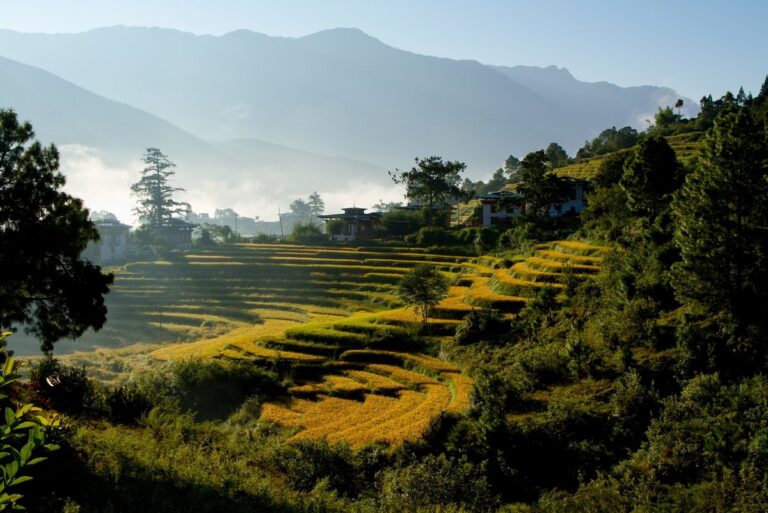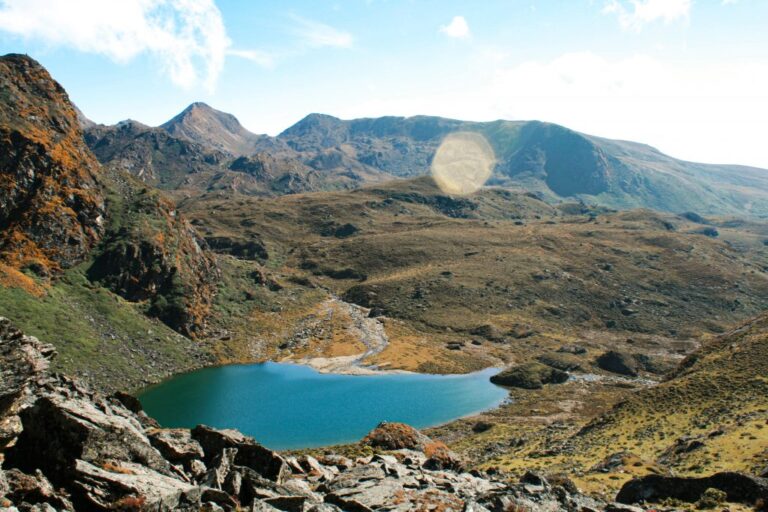Jomolhari Trek
- HOME
- Jomolhari Trek
Fly to Paro, a historic town located in western Bhutan with tiny streets and brightly painted wooden shops. If skies are clear en route, we’ll be treated to views of the massive eastern Himalaya peaks, including Kanchenjunga, which at 28,169 feet is the world’s third-highest mountain, and 24,035-foot Chomolhari, Bhutan’s second largest and the holiest mountain. Once on the ground, you meet your Bhutanese guide and driver, who will greet you with a traditional welcome ceremony. Afternoon visit the National Museum of Bhutan with excellent displays of all facets of the country’s rich cultural history; old costumes and battle dress, thangkas and festive masks, ancient artifacts etc., A few minutes’ drive down is the Paro Rimpung Dzong. In the past, Dzongs acted as strongholds, protecting the vale’s inhabitants in times of war against Tibetans and internal rebellions. Today, it serves as the center for administrative and monastic life and they also houses the offices of the local government and the resident monk body. A few scenes from Bernardo Bertolucci’s Little Buddha (1995) was filmed here. Additionally, the University of Texas in Elpaso in USA is modelled after this Dzong’s architecture and there are few Bhutanese
studying there on scholarships. In the evening your guide will take you through a brief trip orientation and clarify if you have any queries.
Overnight: Janka Resort
Walking distance: 11 km Walking hours: 03 hours Ascent: 300 m/990 ft
In the morning drive past the Drugyel Dzong originally built as a defensive fortress to guard the
valley against Tibetan invasions in the past. We gain our first views of the summit of Jomolhari
(7,314m). On this scenic drive we pass through countryside made up of fields of rice, wheat, mustard, potato, and radish as well as herds of cows. Your car will drop you till Gunitsawa where there’s an army outpost. The feeder road ends at Shana Zam (bridge). Initially the trail is wide and flat as it meanders steadily through lightly forested fields, which in recent years have been the site of the ongoing large-scale Bhutan Government project to bring electricity to the isolated villages further up the valley. It is a reasonable day’s walk today till our campsite by a shallow meadow.
Overnight: Shingkharab campsite
Walking distance: 13 km Walking hours: 5- 6 hours Elevation gain: 770m/2540 ft
Elevation loss: 50m/165 ft
We now trek within Jigme Dorji National Park, the largest protected area in the country (4350 sq. km). The forests are tall and thick, comprising a variety of oaks, maples, birches, larches, pines, alders many varieties of rhododendrons. Many of the camps we stop at are not settlements as might be implied by them having a place name. Most are merely clearings beside a water source, which are also suitable camping sites for seasonal yak herders. From our campsite in one of the meadows we will get to see the closer view of the summit of Mt. Jomolhari.
Overnight: Thangthangkha campsite
Walking distance: 19 km Walking hours: 6-7 hours Elevation gain: ascent: 480 m/1584 ft
Continue higher to the camp at the base of the Jomolhari, a superb alpine setting. Jichu Drake (6794m) rises to our right, with a fine, elegant ridge running down towards the pass that we will cross on our next trekking day. We camp in the vicinity of yak herders from the Paro valley, who like their counterparts in Southern Tibet, live in woven yak wool tents throughout the summer months. By now we are above the tree line and the area is characterized by low tundra of juniper and rhododendron setosum. Blue sheep can be spotted in the higher rocky outcrops.
Overnight: Jangothang campsite
The rest day in Jangothang provides plenty of possibilities for day hikes with snow-capped mountains such as Jomolhari and Jichu Drake. There are good chances to spot some blue sheep on the upper slopes of the valley. Jangothang is a perfect environment for your acclimatization. There are good short hiking trails in three directions. Jomolhari and its subsidiary mountain chains lie directly west, Jichu Drake to the north and there are a number of unclimbed peaks to the east. We will decide on one of the directions to embark onto and explore more of the area.
Overnight: Jangothang campsite
Walking distance: 16 km Walking hours: 7-8 hours
Elevation gain: 810 m/2673 ft Elevation loss: 1090m/3600 ft
The trail today leads us to the last settlement in the valley and passes up to the lake of Tshophu(4,380m) from where one will be treated with the spectacular view of Mt. Jichu Drake with the twin lakes. We then climb up steeply to Bonte La pass, the highest point of this trek route. Reaching the Dhumzo Chhu River, you trek downstream passing the few houses of Soi Yaktsa (Dhumzo) to arrive at your camp soon after. Enroute to campsite, if time permits, we will visit one of the nomads house nearby to get a glimpse of yak herder and his family.
Overnight: Soi Yaktsa campsite
Walking distance: 11 km Walking hours:
Elevation gain: 720m/2376 ft Elevation loss: 340m/1122 ft
The fun of trekking is in taking the views of Bhutan’s majestic Himalayan mountains. We will be walking through meadows and come across meandering streams and will be mostly walking over the ridge today. Climbing up to Takhung La pass (4,520m), we then descend all the way down to Thombushong, yet another beautiful meadow with three yak herder huts close to our campsite.
Overnight: Thombushong campsite
Walking distance: 13km Walking hours: 5-6hours
Elevation gain: 200m/660ft Elevation loss: 1650m/5445ft
After a steep climb out of camp we leave the remote mountain area by following a ridge and towards a vantage point from where we get a glimpse of the Paro Valley to the south before we
start our steep descent for most of the afternoon. Crossing Thombu La pass (4,380m) we will finally reach Gunitsawa where we will be welcomed by representatives from our office to congratulate with TASHI DELEK scarves on the success of this memorable trek. Be treated with
Bhutan beer and sumptuous late lunch. Afternoon explore Paro town. The main street, only built in 1985, is lined with colorfully painted wooden shop fronts and restaurants and handicrafts for souvenirs. Paro remains one of the best Bhutanese towns to explore on foot and is worth an hour or two’s stroll at the end of a day of sightseeing. Free time and souvenirs.
Overnight: Janka Resort
Our representatives will check you into the hotel and bid their farewells from there. We hope you had a wonderful time in Bhutan with us. We look forward to staying in touch.
Tashi Delek & Bon Voyage.



